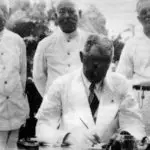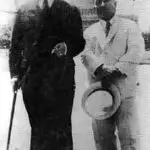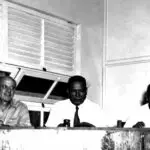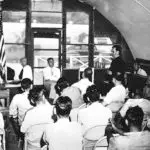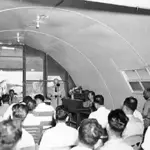Guam Congress Walkout
Table of Contents
Share This
Quest for self-governance
On 5 March 1949, the Guam Congress walked out as a protest against the US Naval Government and to underscore its quest for a measure of self-government and US citizenship. The protest drew nationwide attention through the press, and thereafter fairly quick action by the US Congress and President Harry Truman.
Within two months of the walkout, Truman submitted a bill to Congress to transfer the administration of Guam from the Navy to the Department of the Interior. He soon after transmitted Bill H.R. 4499, Guam’s draft organic act, that would give US citizenship to all the native inhabitants of Guam for the first time, and give the residents of Guam the greatest measure of self-government they had ever had in 300 years of colonial rule.
While the Guam Congress Walkout was only the culmination of five decades of local discontent with the status quo of naval rule, and was followed by a concerted effort by CHamoru/Chamorro leaders to get the US Congress to pass the Organic Act of Guam, the walkout nevertheless set in motion this momentous chain of events. It was the spark that was missing from the frustrating citizenship quest that had been led in previous decades by Francisco B. Leon Guerrero, Baltazar J. Bordallo and others. The walkout was also the most openly rebellious act that Chamorros had committed against any of their colonial rulers since the Chamorro-Spanish wars in the late 1600s.
Discontent with naval government
The Guam Congress Walkout wasn’t an event that sprung from the spontaneous feelings of the leaders of Guam in 1949. It was the climax of half a century of discontent among many Chamorros on Guam with their lack of self-government, lack of basic human rights and the denial of the dignity of US citizenship.
Under Spanish colonial rule, Chamorros eventually had some electoral participation in the various district governments on Guam. In 1898, when the Americans took over Guam during the Spanish-American war, Spanish officials were removed from the island and returned to the Philippines, leaving no one in charge. After various people decided they should be governor, local leaders formed a council who named a governor for Guam. He never actually led the island as an American ship arrived on Guam that same day and someone else was appointed governor. This body was eliminated under American naval rule.
From the beginning of the American governance of the island, the Chamorros expressed a desire to participate in government. In December 1901, thirty-two prominent citizens of Hagåtña sent a petition to the US Congress expressing happiness that Guam was now under the United States, but extreme dissatisfaction with being under military rule. Guam’s citizens had “fewer permanent guarantees of liberty and property rights” under naval rule than under the Spanish, the petition said, and they respectfully asked for more democratic institutions.
A few months later, several Guam citizens petitioned for US citizenship for the first time. It wouldn’t be until nearly fifty years later, however, that citizenship would be granted to the people of Guam.
The only participation in the government provided to the people of Guam came in the form of the Guam Congress. The first official Guam Congress, formed in 1917, was appointed by the governor and had no legislative powers. It was basically a formal advisory body to the naval governor, who could then follow the Congress’ recommendations or ignore them.
The local leaders were very happy to finally be able to participate in the government, even if it was in a limited form, but they made it clear from the beginning that the most important issue to them was the question of Guam’s political rights and a more democratic form of government under the United States. This first Guam Congress repeatedly passed resolutions calling for Guam’s governor to petition the US Congress to deal definitively with the issue of Guam’s civil status and political rights.
In the 1920s, the local leaders used a different tactic, petitioning for citizenship the various important officials who visited Guam, including senators, congressmen and high-ranking naval officials.
In the early 1930s, Governor William Bradley several times recommended in his reports to the Naval Department that federal legislation be enacted granting US citizenship to the Chamorro people. The Guam Congress unanimously endorsed his recommendations. Bradley further recommended that Washington grant a bill of rights to the Chamorro people, and instead of waiting for departmental approval, proclaimed a Bill of Rights for the people of Guam in 1930.
As local interest in the appointed and powerless Guam Congress declined, Bradley also formed the second Guam Congress. It consisted of two houses – the House of Council and the House of Assembly – and its members for the first time were elected by the people of their districts. The first general election in the history of the island took place on March 7, 1931. However, although the people of Guam greatly appreciated being given the chance to elect their leaders, the second Guam Congress remained an advisory body. When it soon became clear that the recommendations of this Congress were to be as ignored as those of the previous Congress, interest by both the leadership and the citizens in participating severely declined.
In 1933, the Chamorro leadership organized an island-wide petition drive for US citizenship that resulted in 1,965 signatures, but the US Congress took no action on the petition. In 1937, the Guam Congress sent two official delegates, Baltazar J. Bordallo and Francisco B. Leon Guerrero, to Washington D.C. to transmit another petition for US citizenship. And while these delegates were able to get Congress to introduce and discuss a bill to grant such citizenship, official opposition by the Navy killed the bill.
After four decades of attempting to get the US government to recognize their pleas for justice, their quest for citizenship, and their desire for a greater measure of participation in a truly democratic American form of government, the Chamorro people grew increasingly frustrated by the lack of any type of action.
Conflict with Pownall
In the aftermath of World War II, the Chamorro leaders renewed their quest for citizenship and self-government, again petitioning the US Congress to grant US citizenship to Chamorros and to enact an organic act to create a government for Guam. F.B. Leon Guerrero led fifteen prominent Chamorros, including Judge Jose C. Manibusan, Father Oscar Calvo, Simon A. Sanchez and B.J. Bordallo, who called themselves the Friends of Guam and sought an end to the naval rule of Guam.
When the eighth Guam Congress sent a resolution to Washington requesting for US citizenship and an organic act for Guam in 1947, it met with a growing debate in Washington over Guam’s governance. In that year, two separate committees in Washington issued reports recommending that citizenship be granted, that civil government be established on Guam and that a civilian agency be given charge over the administration of Guam. Several bills were introduced in the US Congress reflecting these recommendations, and had very active stateside advocates, but they ultimately failed.
In 1948, the new naval governor, Charles A. Pownall, and the Secretary of the Navy issued a proclamation giving the Guam Congress unprecedented powers to create new laws for Guam, upon the governor’s approval, and the power to approve laws proposed by the naval governor. The Secretary of the Navy had the power to override the veto of either branch. This proclamation was very well received by Chamorros, and was later dubbed the Interim Organic Act. It greatly alleviated growing tensions and a deteriorating relationship between locals and the navy.
It wasn’t long, however, before locals discovered that not much had changed – the governor could still pass laws by himself when the Guam Congress was not in session, which was most of the time, and when he vetoed legislation he had the backing of the Secretary of the Navy.
Over the next two years, Chamorros grew increasingly frustrated and outraged by the naval administration, due to numerous abuses with military condemnations of local land, and to the unfair wage discrimination against local workers and in favor of thousands of new off-island American contractors.
In early 1949, as the Guam Congress considered two new measures to petition for citizenship and an organic act, a controversy arose over the power of the Guam Congress to subpoena American citizens. A Guam House of Assembly committee, investigating violations of a prohibition against Americans owning local businesses through Guamanian “front men,” subpoenaed an American civilian, Abe Goldstein, who had financed a women’s clothing store. The civilian refused to testify, citing Pownall’s veto the year before of the Guam Congress’ power to subpoena Americans.
The Guam Congress had a confrontation with Pownall which stirred up media attention in support of the bill for an organic act and the petition for citizenship. The committee issued a warrant for the Goldstein’s arrest, citing him for contempt, and Pownall intervened and halted the execution of the warrant. Pownall told Speaker of the House of Assembly, Antonio Won Pat, to refer the matter to the executive branch. Won Pat relayed that advice to the House of Assembly on March 5, the day the Assembly was debating the controversial organic act bill and the petition for citizenship.
Walkout and the press
Angered by Pownall’s actions, the assembly passed the bill and petition, and voted unanimously to adjourn until the US Congress acted on the organic act bill. A young assemblyman, Carlos P. Taitano, had recently been captain of the US Army and knew very well the power of the American press. He had met earlier in the year with two visiting newsmen from the United Press International (UPI) and the Associated Press (AP) bureaus in Honolulu, and got them to agree to file stories in return for exclusive reports from Taitano.
As soon as the Guam Congress voted on the walkout, Taitano rushed to report to his press contacts in Honolulu by telegram, without telling his colleagues. The wire services quickly filed the news, and the New York Times reported “Guam Assembly Quits” on March 6 and “Congress Walkout” on March 7.
Pownall called for a special joint session of the Congress for March 12, but the Congress members met the day before and decided not to attend. Through Taitano’s reports, the Honolulu Advertiser wrote “Guam Congress Revolt Grows”, on March 12. Pownall then dismissed the members of the Guam Congress who had willfully violated the law, and announced that he would appoint their replacements.
This announcement was immediately met by hostile public reaction, and meetings in twelve villages declared that the people would not recognize any of the appointees. Meanwhile, the mainland news media continued to report on the Guamanian defiance of the military government. In an article in the Washington Post, Taitano was quoted as saying that the political revolt grew out of three long-standing grievances:
- Arbitrary rule by naval government
- Lack of a constitution or documents anywhere guaranteeing civil rights
- Lack of a court of appeal beyond the Secretary of the Navy.
Aftermath
President Harry Truman, who was well informed about Guam, reacted to the walkout by asking the State Department for an assessment. The State Department recommended that the Department of the Interior take over administration of Guam within a year. The White House then instructed the Interior Department to draft an organic act for civilian government of Guam, and Truman approved the draft on 14 May and notified the Navy that it would have to turn over administration of Guam to the Interior within twelve months.
As Navy and Interior worked out a transition plan, Pownall responded to pressure from Washington by restoring Guam’s elected assemblymen to their seats on April 2. In May, the Guam Congress returned, and soon decided to send FB Leon Guerrero and Antonio B. Won Pat to Washington to lobby for the passage of an organic act. Other Chamorros also lobbied for the Organic Act in Washington, including Agueda Johnston, Concepcion Barrett and B.J. Bordallo.
In September 1949, the administration of Guam was transferred to the Interior Department, and Truman appointed Carlton S. Skinner as Guam’s first civilian governor. A united front by Chamorros, Skinner and others resulted in the passage of the Organic Act of Guam in 1950, and on 1 August 1950, President Truman signed it into law. Carlos Taitano was the only Chamorro present at the signing as he was attending college in the area at the time.
For further reading
Christian Science Monitor. “Military Rule Ends in Guam: And People Become U.S. Citizens.” 7 August 1950.
Hattori, Anne Perez. “Righting Civil Wrongs: The Guam Congress Walkout of 1949.” ISLA: A Journal of Micronesian Studies 3, no. 1 (Rainy Season 1995): 1-27.
Hinasso’: Tinige’ Put Chamorro–Insights: The Chamorro Identity. Hagåtña: Political Status Education Coordinating Committee, 1993.
Honolulu Advertiser. “Guam Congress Revolt Grows.” 11 March 1949.
Honolulu Star-Bulletin. “Admiral Steps Into Guam’s New Fight Over Naval Rule.” 11 March 1949.
Kinalamten Pulitikåt: Siñenten I Chamorro (Issues in Guam’s Political Development: The Chamorro Perspective). The Hale’-ta Series. Hagåtña: Political Status Education Coordinating Commission, 1996.
Rogers, Robert. Destiny’s Landfall: A History of Guam. Honolulu: University of Hawai’i Press, 1995.

